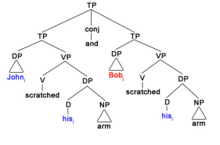In linguistics, sloppy identity is an interpretive property that is found with verb phrase ellipsis where the identity of the pronoun in an elided VP (verb phrase) is not identical to the antecedent VP.
For example, English allows VPs to be elided, as in example (1). The elided VP can be interpreted in at least two ways, as follows:
- The "strict" reading: sentence (1) is interpreted as (1a), where the pronoun his denotes the same referent in both the antecedent VP and the elided VP. In (1a), the pronoun his refers to John in both the first and the second clause. This is done by assigning the same index to John and to both the "his" pronouns. This is called the "strict identity" reading because the elided VP is interpreted as being identical to the antecedent VP.
- The "sloppy" reading: sentence (1) is interpreted as (1b) where the pronoun his refers to John in the first clause, but the pronoun his in the second clause refers to Bob. This is done by assigning a different index to the pronoun his in the two clauses. In the first clause, the pronoun his is co-indexed with John, in the second clause, pronoun his is co-indexed with Bob. This is called the "sloppy identity" reading because the elided VP is not interpreted as identical to the antecedent VP.
1) John scratched his arm and Bob did too. a. Strict reading: Johni scratched hisi arm and Bobj [scratched hisi arm] too. b. Sloppy reading: Johni scratched hisi arm and Bobj [scratched hisj arm] too.

